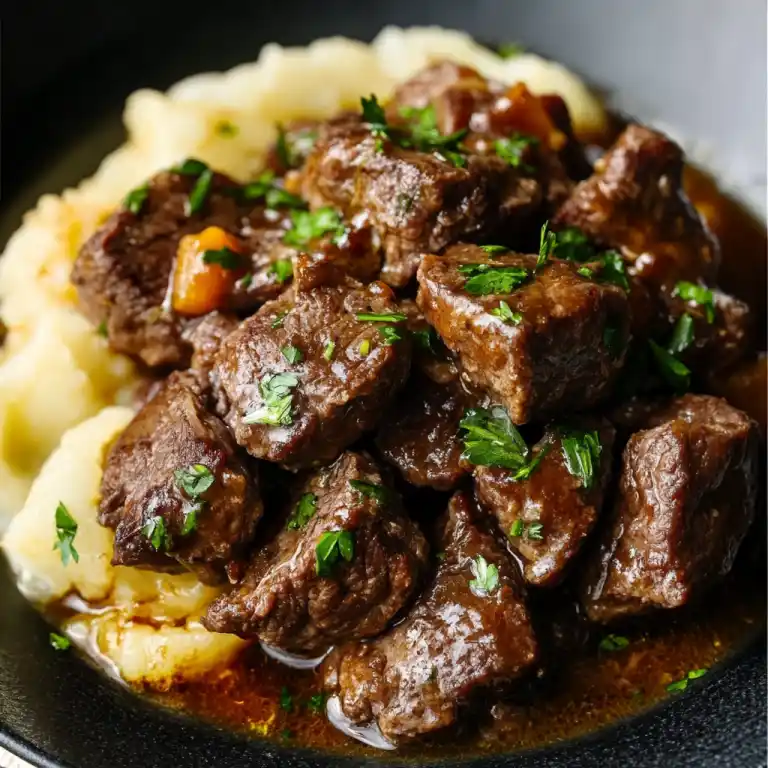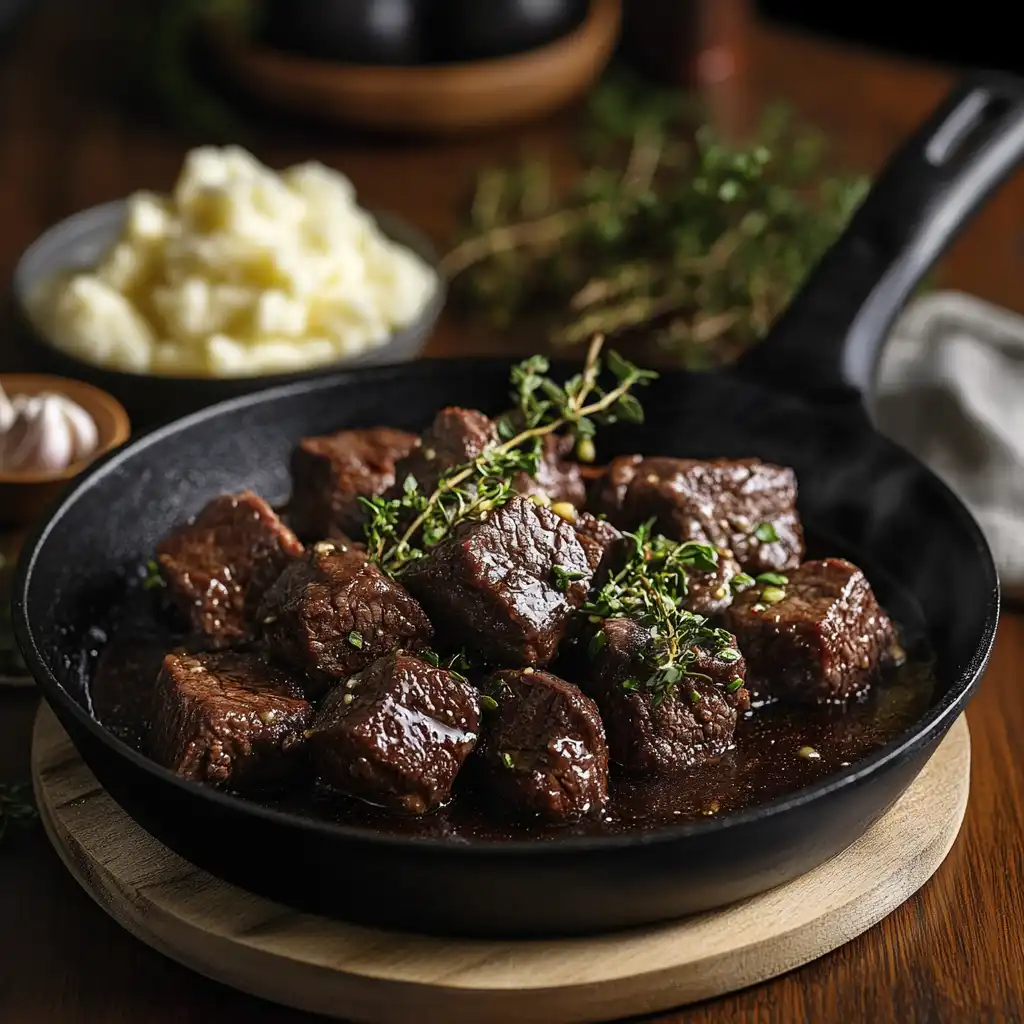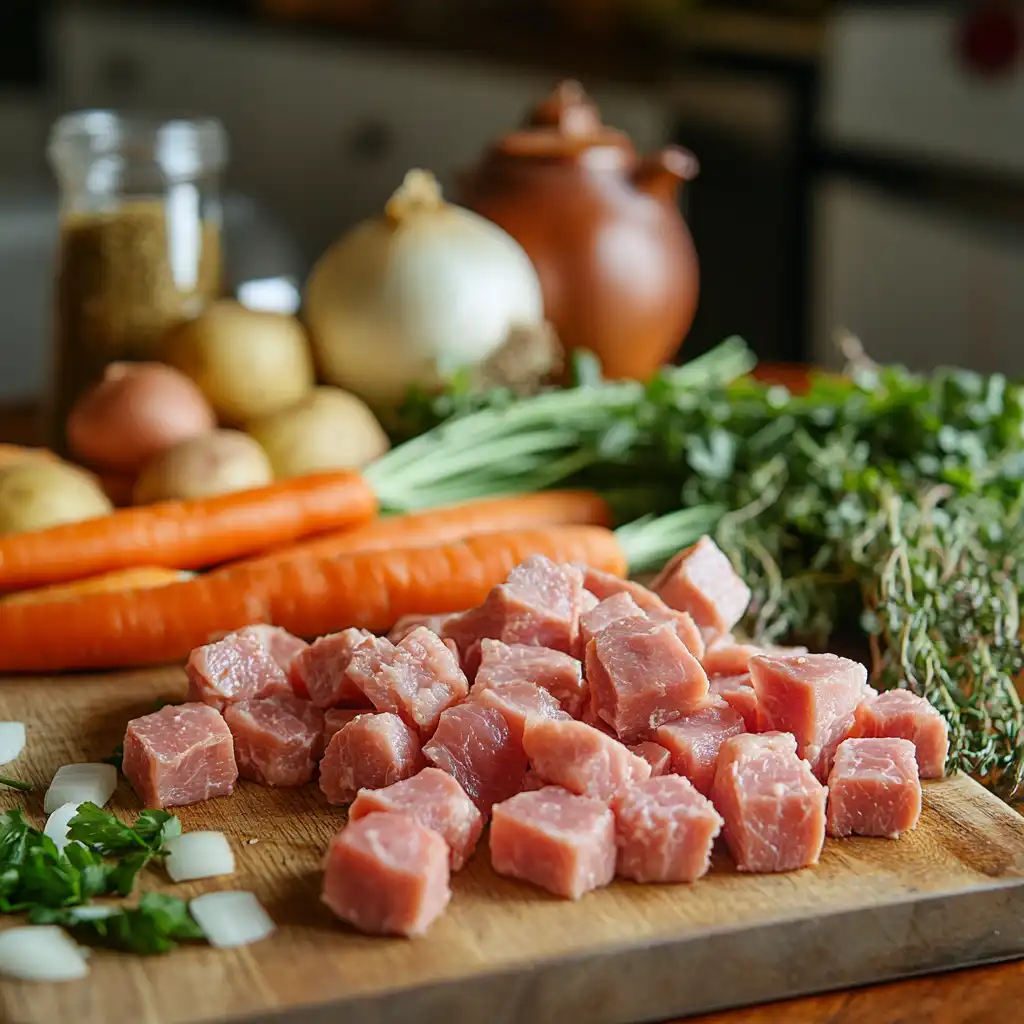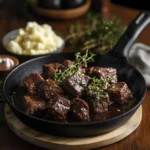
When it comes to cooking, understanding the difference between stew meat vs beef tips can make a big difference in flavor and texture. While they may seem similar, these two types of beef are suited for very different culinary purposes.
Table of Contents
Understanding Stew Meat
What is Stew Meat?
Stew meat is ideal for recipes that require slow cooking. Unlike beef tips, stew meat comes from tougher cuts of the cow, such as chuck or round. For those comparing stew meat vs beef tips, it’s important to note that stew meat excels in dishes like hearty soups or slow-cooked stews.
Common Cuts Used for Stew Meat
Stew meat usually comes from the tougher, leaner parts of the cow, as these cuts benefit from slow cooking to break down their fibers. Common cuts include:
- Chuck: A popular choice due to its rich flavor and marbled texture.
- Round: A leaner option from the rear of the cow.
- Brisket: Known for its strong flavor, though less common for stew.
Characteristics of Stew Meat
- Texture: Tough and fibrous when raw but becomes tender with cooking.
- Flavor: Deep, robust flavor ideal for hearty dishes.
- Preparation: Best suited for long, slow cooking methods such as braising or simmering.
What Are Beef Tips?
Definition of Beef Tips
Beef tips are perfect for quick-cooking recipes. When deciding between stew meat vs beef tips, remember that beef tips often come from more tender cuts like sirloin or tenderloin, making them ideal for sautés or gravies.
Typical Cuts Used for Beef Tips
Beef tips may come from a variety of tender cuts, such as:
- Sirloin: Known for its tenderness and fine texture.
- Tenderloin or Filet Mignon: Premium cuts occasionally used for beef tips.
- Tri-Tip or Other Cuts: Depending on availability, other tender portions may also be used.
Characteristics of Beef Tips
- Texture: Tender, making them suitable for quicker cooking methods.
- Flavor: Mild yet rich, capable of absorbing marinades and sauces.
- Preparation: Ideal for sautéing, grilling, or incorporating into gravy-based dishes.
While both stew meat and beef tips involve cubed beef, their uses, cuts, and preparation methods are distinct. Stew meat is a cost-effective choice for slow-cooked, flavorful meals, whereas beef tips are more suited to quick, tender dishes that showcase their quality. Knowing the difference ensures you’ll choose the right option for your culinary creation.
Key Differences Between Stew Meat and Beef Tips
Source of the Meat
- Stew Meat: Derived from tougher, less expensive cuts of beef, such as chuck, round, or brisket. These cuts require long cooking times to break down their connective tissue.
- Beef Tips: Typically come from more tender and premium cuts like sirloin, tenderloin, or tri-tip. Beef tips are often trimmed from portions of steak or roast.
Texture and Tenderness
- Stew Meat: Starts off tough and fibrous but becomes tender and flavorful after extended cooking.
- Beef Tips: Naturally tender, allowing them to be cooked quickly without the need for prolonged cooking to achieve softness.
Uses in Cooking
- Stew Meat: Best suited for hearty dishes such as stews, soups, or braised meals where the meat can simmer for hours.
- Beef Tips: Commonly used in quick dishes like stir-fries, gravies, kebabs, or over rice or noodles, where the meat’s natural tenderness is showcased.
How Are Stew Meat and Beef Tips Prepared?

Preparation Techniques for Stew Meat
- Trimming: Any excess fat or gristle is removed from the cuts.
- Cubing: The meat is cut into uniform cubes, ensuring even cooking.
- Seasoning or Marinading: For added flavor, stew meat may be seasoned with spices or marinated before cooking.
- Flouring (Optional): Coating the cubes in flour helps thicken the stew and provides a golden crust when seared.
Preparation Techniques for Beef Tips
- Trimming: The meat is trimmed of excess fat for a clean, lean bite.
- Cubing or Slicing: Beef tips are typically cut into smaller, uniform pieces for quick cooking.
- Marinading (Optional): Often marinated to enhance flavor and tenderness, especially for grilling or sautéing.
Cooking Methods for Both
Stew Meat:
- Slow Cooking or Braising: Stew meat is cooked low and slow, often submerged in a liquid such as broth or wine, to tenderize it and allow flavors to meld.
- Pressure Cooking: A faster alternative that achieves the same tenderness.
- Simmering: Used in soups and stews, letting the meat absorb the dish’s flavors.
Beef Tips:
- Sautéing: A quick cooking method ideal for gravies and stir-fries.
- Grilling or Pan-Searing: Beef tips can be flash-cooked for a caramelized exterior.
- Broiling: Occasionally used for dishes that require even browning.
Understanding the key differences and preparation methods for stew meat and beef tips allows for greater flexibility in creating delicious dishes. Whether you’re simmering a stew on a chilly evening or whipping up a quick stir-fry, choosing the right type of meat is crucial to achieving the desired texture and flavor.
Nutritional Comparison
Protein Content
- Stew Meat: Often derived from leaner cuts such as round, stew meat typically has a high protein content, ideal for muscle repair and maintenance.
- Beef Tips: Sourced from more tender and sometimes fattier cuts, beef tips also provide ample protein but may vary slightly based on the specific cut.
Fat and Calorie Differences
- Stew Meat: Generally lower in fat and calories due to its lean origins, though the nutritional profile may shift depending on preparation methods, like adding fats for cooking.
- Beef Tips: May contain slightly more fat and calories, particularly if sourced from marbled cuts like sirloin, enhancing flavor but increasing calorie density.
Additional Nutritional Benefits
- Stew Meat: Rich in iron and zinc, supporting immune function and energy levels. Slow cooking often preserves these nutrients.
- Beef Tips: Shares similar benefits but may offer slightly more flavor-enhancing fat-soluble vitamins like vitamin B12, depending on the cut.
Flavor Profiles of Stew Meat and Beef Tips

How Seasoning Affects Stew Meat
Stew meat’s robust flavor develops over time during slow cooking. It benefits greatly from seasoning blends and marinades that enhance the dish’s depth. Ingredients like garlic, onions, bay leaves, and wine infuse their flavors into the meat over time.
The Natural Taste of Beef Tips
Beef tips, often sourced from tender and flavorful cuts, have a natural richness that can shine even with minimal seasoning. Quick cooking preserves their original taste, making them versatile for various cuisines.
Complementary Spices and Ingredients
- Stew Meat: Pairs well with hearty spices such as paprika, thyme, rosemary, and cumin, as well as root vegetables like carrots and potatoes.
- Beef Tips: Works excellently with bold marinades featuring soy sauce, garlic, ginger, or Worcestershire sauce. They can also complement quick sauces like mushroom or peppercorn gravy.
Cost and Availability
Typical Pricing of Stew Meat
Stew meat is usually more affordable, as it is sourced from tougher cuts that require extended cooking. Pricing varies by region but is considered a budget-friendly option for hearty meals.
Pricing for Beef Tips
Beef tips are typically pricier, reflecting their origin from tender and sometimes premium cuts. Prices can fluctuate based on whether the beef tips come from sirloin, tenderloin, or trimmings of steak cuts.
Availability in Markets and Stores
- Stew Meat: Readily available in most grocery stores and butcher shops, often pre-cut and labeled for convenience.
- Beef Tips: Availability may vary, as beef tips are not always pre-packaged. They may need to be requested at butcher counters, especially if sourced from premium cuts.
By understanding the nutritional differences, flavor profiles, and cost considerations, you can choose the right option—stew meat or beef tips—for your specific culinary needs and dietary preferences. Whether you’re preparing a slow-cooked stew or a quick sautéed dish, knowing these factors will elevate your cooking experience.
Best Recipes for Stew Meat
Classic Beef Stew
The ultimate comfort food, classic beef stew combines tender chunks of stew meat with potatoes, carrots, and onions in a rich, savory broth. Cooked low and slow, it’s a timeless dish that warms the soul.
Slow-Cooked Stew Recipes
Stew meat shines in slow cooker recipes like red wine beef stew, where the extended cooking time allows the meat to absorb complex flavors from ingredients like garlic, thyme, and tomato paste.
Variations Using Stew Meat
- Mexican Beef Stew: Incorporate chili peppers, cumin, and tomatoes for a spicy twist.
- Asian-Style Stew: Add soy sauce, ginger, and star anise for a unique flavor profile.
- Vegetable-Loaded Stew: Emphasize seasonal vegetables for a lighter, nutrient-rich dish.
Popular Dishes Featuring Beef Tips
Beef Tips with Gravy
A classic dish that pairs tender beef tips with a rich, savory gravy. Often served over rice, mashed potatoes, or noodles, it’s a comforting and hearty option.
Beef Stroganoff
Beef tips are perfect for this creamy Russian-inspired dish. Cooked with mushrooms, onions, and sour cream, it’s a quick yet elegant meal served over egg noodles.
Creative Recipes for Beef Tips
- Beef Skewers: Marinate and grill beef tips for flavorful kebabs.
- Stir-Fried Beef Tips: Quick and easy, stir-fry beef tips with vegetables and soy-based sauces.
- Beef Tips Tacos: Use seasoned beef tips as a filling for soft tortillas with fresh toppings.
Which Option is Better for Your Dish?
Considerations for Stews
Stew meat is ideal for dishes requiring slow cooking, as it develops a tender texture and deep flavor over time. It’s the best choice for hearty, brothy meals.
Dishes Better Suited for Beef Tips
Beef tips are better for quick-cooking recipes like stir-fries, gravies, or sautéed dishes. Their tenderness makes them versatile for dishes with shorter preparation times.
Culinary Versatility of Each
- Stew Meat: Best for traditional, slow-cooked dishes with robust flavors.
- Beef Tips: Adaptable to a wide range of cuisines and cooking techniques.
How to Choose Quality Meat?
Tips for Selecting Fresh Stew Meat
- Look for a bright red color, indicating freshness.
- Avoid packages with excess liquid or discoloration.
- Check for even, uniform cuts to ensure consistent cooking.
Identifying Good Beef Tips
- Opt for cuts with visible marbling for extra tenderness and flavor.
- Choose beef tips that appear moist but not wet.
- Ask your butcher about the source cut for assurance of quality.
Signs of Freshness and Quality
- A pleasant, mild odor.
- Firm, springy texture when touched.
- Packaging should be tight and intact with clear labeling.
Storage and Shelf Life
Best Practices for Storing Stew Meat
- Store in the coldest part of the refrigerator (below 40°F).
- Use within 2-3 days of purchase for best quality.
- Keep in original packaging or transfer to an airtight container.
Storing Beef Tips Properly
- Refrigerate beef tips immediately after purchase.
- If not using within 2 days, freeze them to maintain quality.
- When freezing, wrap tightly in plastic and aluminum foil or vacuum-seal.
Freezing Tips and Tricks
- Label packages with the date to track storage time.
- Freeze in portions to make defrosting easier.
- Beef can be stored in the freezer for up to 6 months for best quality.
Expert Tips for Cooking with Stew Meat and Beef Tips
Techniques for Enhancing Flavor
- Stew Meat: Brown the meat before slow cooking to lock in flavor. Deglaze the pan with broth or wine to add depth to the dish.
- Beef Tips: Marinate for a few hours to infuse flavors before cooking. Use high heat to quickly sear and enhance the natural taste.
Avoiding Common Cooking Mistakes
- Don’t rush stew meat; undercooking can leave it tough.
- Avoid overcooking beef tips, which can dry them out.
- Season both meats adequately to complement their natural flavors.
Achieving Perfect Tenderness
- Use a slow cooker or Dutch oven for stew meat to ensure it breaks down properly.
- For beef tips, aim for medium-rare to medium doneness for optimal tenderness.
- Rest cooked meat for a few minutes before serving to retain juices.
By following these guidelines, you can make the most of stew meat and beef tips in your cooking, ensuring delicious and satisfying results every time.
Frequently Asked Questions About Stew Meat and Beef Tips
What Are Stew Meat Substitutes?
If you don’t have stew meat on hand, consider these alternatives:
- Beef Chuck Roast: Cube it yourself for a similar texture and flavor.
- Bottom Round Roast: Another tough cut that works well for slow cooking.
- Brisket: Adds rich flavor, though it requires a longer cooking time.
- Pork Shoulder or Lamb Shoulder: Great substitutes for beef in stews, offering similar cooking properties.
Can Beef Tips Be Used in Stews?
Yes, beef tips can be used in stews, especially if they come from less tender cuts like sirloin trimmings. However, premium cuts like tenderloin might not hold up well in prolonged cooking, as they can become overly soft or lose their texture.
What Is the Best Cut for Beef Tips?
The best cuts for beef tips include:
- Sirloin: A popular choice for its tenderness and flavor.
- Tenderloin or Filet Mignon: More expensive but exceptionally tender.
- Tri-Tip or Ribeye Trimmings: Provide a balance of tenderness and marbling.
Is Stew Meat Always Tough?
Stew meat is naturally tough because it comes from parts of the cow with more connective tissue and muscle. However, slow cooking or braising breaks down these fibers, resulting in tender, flavorful meat. Proper cooking techniques are essential to achieve the desired tenderness.
Are Beef Tips Better for Slow Cooking?
Beef tips are not typically ideal for slow cooking, as they are already tender and do not require extended cooking times. However, sirloin-based beef tips can work in slow-cooked dishes if a quicker cooking time is preferred.
How to Tenderize Stew Meat Effectively?
- Marination: Use acidic ingredients like vinegar, wine, or citrus juice to break down tough fibers.
- Mechanical Tenderizing: Pound the meat gently with a meat mallet.
- Cooking Methods: Braise or slow-cook the meat for several hours to naturally tenderize it.
- Salt: Rub the meat with salt before cooking to draw out moisture and relax the fibers.
By understanding these common questions, you can confidently select and prepare stew meat or beef tips for a wide variety of recipes.
Can You Substitute Stew Meat for Beef Tips?
Yes, stew meat can be substituted for beef tips in many recipes, but the results may differ depending on the cooking method. Stew meat is tougher and requires slow cooking to become tender, whereas beef tips are naturally tender and better suited for quicker cooking methods. If substituting, ensure you adjust the cooking time to match the texture of the meat.
What Kind of Meat Are Beef Tips Made From?
Beef tips are typically made from tender cuts of beef, such as:
- Sirloin: The most common source, providing a balance of tenderness and flavor.
- Tenderloin: Occasionally used for premium beef tips.
- Tri-Tip or Ribeye Trimmings: Less common but still tender options.
In some cases, beef tips can be made from trimmings of various steak cuts or roasts.
What Is Another Name for Beef Tip?
Beef tips may also be referred to as:
- Sirloin Tips: When made specifically from the sirloin cut.
- Steak Tips: A term used interchangeably in some regions, depending on the source cut.
These names often highlight the origin of the meat, indicating its tenderness and quality.
Is Stew Meat the Same as Beef Tips?
Beef is a staple protein in countless recipes, but terms like stew meat and beef tips can sometimes cause confusion. While both involve cubed cuts of beef, their characteristics, preparation, and uses in cooking are quite distinct. This article clarifies the differences and helps you make the best choice for your culinary needs.
Understanding Stew Meat
What is Stew Meat?
Stew meat refers to diced or cubed pieces of tougher beef cuts, ideal for slow-cooked dishes. These pieces are often taken from the leaner, more muscular parts of the cow, such as chuck, round, or brisket.
Characteristics of Stew Meat
- Texture: Starts tough but becomes tender with prolonged cooking.
- Flavor: Rich and hearty, perfect for absorbing seasonings and broths.
- Uses: Best suited for dishes like classic beef stews or braised recipes.
For a deeper dive into crafting dishes with beef, consider exploring The Ultimate Guide to the Perfect Beef Tips Recipe, which provides ideas for tender and flavorful beef recipes.
What Are Beef Tips?
Definition and Cuts
Beef tips are small, tender pieces of beef often sourced from premium cuts such as sirloin or tenderloin. They’re perfect for quick-cooking dishes due to their naturally soft texture.
Characteristics of Beef Tips
- Texture: Naturally tender and doesn’t require long cooking times.
- Flavor: Mild yet rich, suitable for various cuisines.
- Uses: Ideal for quick dishes like stir-fries, gravies, or over rice.
Key Differences Between Stew Meat and Beef Tips
- Source: Stew meat comes from tougher cuts, while beef tips are typically cut from tender portions like sirloin.
- Cooking Method: Stew meat thrives in slow cooking, while beef tips are best in quick-cooking recipes.
- Price: Beef tips are often more expensive due to their premium origin.
For readers who want to try beef tips in their own kitchens, check out The Ultimate Guide to the Perfect Beef Tips Recipe for step-by-step preparation tips.
When to Use Each
- Choose Stew Meat: When making hearty stews, soups, or braised dishes requiring long cooking times.
- Choose Beef Tips: When preparing quick, flavorful dishes that highlight the tenderness of the beef.
Conclusion: Choosing the Right Meat for Your Needs
Summary of Differences
Stew meat and beef tips each have their unique characteristics and culinary applications:
- Stew Meat: Derived from tougher cuts like chuck or round, it is perfect for slow-cooked dishes where time transforms it into tender, flavorful morsels.
- Beef Tips: Cut from naturally tender portions such as sirloin or tenderloin, beef tips are ideal for quick-cooking recipes that highlight their tenderness and rich flavor.
Key Takeaways
- Use stew meat when preparing hearty, slow-cooked meals like stews or braises.
- Opt for beef tips when creating fast, flavorful dishes such as stir-fries or gravies.
- Consider cost and cooking time—stew meat is budget-friendly but requires patience, while beef tips may cost more but save time.
By understanding the differences and knowing when to use each, you can make informed choices for your recipes. Whether you’re crafting a comforting stew or a quick sauté, selecting the right meat ensures a delicious outcome every time.
Classic Beef Stew
Equipment
- Dutch Oven
Ingredients
Beef Stew Meat
- 2 pounds stew meat cut into cubes
- 4 medium potatoes peeled and cubed
- 3 medium carrots sliced
- 1 large onion chopped
- 2 cloves garlic minced
- 1 cup beef broth
- 1 cup red wine
- 1 tablespoon tomato paste
- 1 teaspoon thyme
- salt salt to taste
- pepper black pepper to taste
Instructions
- Heat a Dutch oven over medium-high heat. Add the beef cubes and brown them on all sides.
- Remove the beef from the pot and set aside. In the same pot, add oil if needed, then sauté the onion and garlic until fragrant.
- Add the potatoes, carrots, beef broth, red wine, tomato paste, bay leaf, thyme, salt, and black pepper to the pot. Stir well.
- Return the beef to the pot. Bring the mixture to a boil, then reduce the heat to low, cover, and simmer for about 3 hours or until the beef is tender.
- Adjust seasoning if necessary. Serve hot with crusty bread.

